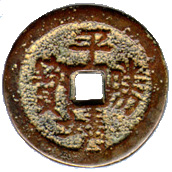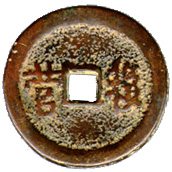 ]
]| Home Page | New Data | Chronology | Cast Coins | Struck Coins | Paper Money | Links/Reference |
 ]
]
Most of the relics of the Tien Ti Hui  were destroyed by the Qing (Ch'ing) Government after the insurrections was suppressed. They continued to suffer from damage or fall into oblivion after repeated turmoils of China's society. And as a result, very few of the Tien Ti Hui coins had survived till this day. This coin may be an exception. Until now, I can not decide whether this cash coin is genuine, I have my suspicions. were destroyed by the Qing (Ch'ing) Government after the insurrections was suppressed. They continued to suffer from damage or fall into oblivion after repeated turmoils of China's society. And as a result, very few of the Tien Ti Hui coins had survived till this day. This coin may be an exception. Until now, I can not decide whether this cash coin is genuine, I have my suspicions.
|
| No. 034 | 
|
This "P'ing Tsing Sheng Pao" coin is large as the five cash.
The colour of this cash is very strange to me, I find that those 'P'ing Tsing cash that I have seen before were made of brass, but this cash was made of copper. I hardly to identify it. coin is large as the five cash.
The colour of this cash is very strange to me, I find that those 'P'ing Tsing cash that I have seen before were made of brass, but this cash was made of copper. I hardly to identify it."P'ing Tsing" coins were occasionally unearthed in the provinces of Kwangtung, Kwangsi, Hunan and Hupeh. They were commonly known as the "Taiping Tien Kuo" coins before. But, their colour and inscriptions are different from the "Taiping" coins. Inscriptions bearing on the obverse of this coin are Chinese characters "Ping Tsing Sheng Pao"  , reading from top to bottom and right to left, with the meaning of "The victorious currency of conquering the Ch'ing government". [The characters "Tsing" , reading from top to bottom and right to left, with the meaning of "The victorious currency of conquering the Ch'ing government". [The characters "Tsing"  and "Qing and "Qing  or Ch'ing or Ch'ing  " are homonyms in Chinese. Their meanings could be borrowed between each other in Chinese literature.] Inscriptions on the reverse are Chinese characters "Hou Ying" " are homonyms in Chinese. Their meanings could be borrowed between each other in Chinese literature.] Inscriptions on the reverse are Chinese characters "Hou Ying"  [rear corps]. Other inscriptions bearing on the reverse of "P'ing Tsing" coins included several kinds, such as "Chien Ying" [rear corps]. Other inscriptions bearing on the reverse of "P'ing Tsing" coins included several kinds, such as "Chien Ying"  [front corps], "Tso Ying" [front corps], "Tso Ying"  [left corps], "Yu Ying" [left corps], "Yu Ying"  [right corps], "Chung Ying" [right corps], "Chung Ying"  [central corps], and "Yu Lin Chun" [central corps], and "Yu Lin Chun"  [army for the imperial use only], etc. [army for the imperial use only], etc.
|
| Mint: Kwangsi | ||
| Rareness B | ||
| Diam.28 mm | ||
| Wt. 8.7 g. | 
| |
| Hole Diam. 5mm | ||
| Rim 2.5mm |
|
More about the P'ing Tsing Sheng Pao Coin
In april, 1854, leader of "Sam Ho Hui" In August, 1855, Chen Kai announced the establishment of the "Ta Cheng Kuo"
In 1853, as the great success of the "Taiping Tien Kuo" revolution, the Hsien Feng Emperor found that the "Taiping" rebel had directly influenced the whole country, he orderd to raise the militia force along the Yangtze River districts. Tseng Kuo Fan
In April 1854, Tseng's troops attacked Yao Ch'ou |
| Home Page | New Data | Chronology | Cast Coins | Struck Coins | Paper Money | Links/Reference |